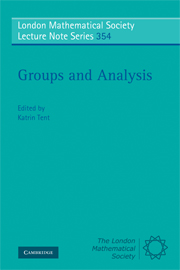Book contents
- Frontmatter
- Contents
- Preface
- List of speakers and talks
- 1 Harmonic analysis on compact symmetric spaces
- 2 Weyl, eigenfunction expansions, symmetric spaces
- 3 Weyl's work on singular Sturm–Liouville operators
- 4 From Weyl quantization to modern algebraic index theory
- 5 Sharp spectral inequalities for the Heisenberg Laplacian
- 6 Equidistribution for quadratic differentials
- 7 Weyl's law in the theory of automorphic forms
- 8 Weyl's Lemma, one of many
- 9 Analysis on foliated spaces and arithmetic geometry
- 10 Reciprocity algebras and branching
- 11 Character formulae from Hermann Weyl to the present
- 12 The Classification of affine buildings
- 13 Emmy Noether and Hermann Weyl
Preface
Published online by Cambridge University Press: 12 May 2010
- Frontmatter
- Contents
- Preface
- List of speakers and talks
- 1 Harmonic analysis on compact symmetric spaces
- 2 Weyl, eigenfunction expansions, symmetric spaces
- 3 Weyl's work on singular Sturm–Liouville operators
- 4 From Weyl quantization to modern algebraic index theory
- 5 Sharp spectral inequalities for the Heisenberg Laplacian
- 6 Equidistribution for quadratic differentials
- 7 Weyl's law in the theory of automorphic forms
- 8 Weyl's Lemma, one of many
- 9 Analysis on foliated spaces and arithmetic geometry
- 10 Reciprocity algebras and branching
- 11 Character formulae from Hermann Weyl to the present
- 12 The Classification of affine buildings
- 13 Emmy Noether and Hermann Weyl
Summary
This volume grew out of the conference in honour of Hermann Weyl that took place in Bielefeld in September 2006.
Weyl was born in 1885 in Elmshorn, a small town near Hamburg. He studied mathematics in Göttingen and Munich, and obtained his doctorate in Göttingen under the supervision of Hilbert. After taking a teaching post for a few years, he left Göttingen for Zürich to accept a Chair of Mathematics at the ETH Zürich, where he was a colleague of Einstein just at the time when Einstein was working out the details of the theory of general relativity. Weyl left Zürich in 1930 to become Hilbert's successor at Göttingen, moving to the new Institute for Advanced Study in Princeton, New Jersey after the Nazis took power in 1933. He remained there until his retirement in 1951. Together with his wife, he spent the rest of his life in Princeton and Zürich, where he died in 1955.
The Collaborative Resarch Centre (SFB 701) Spectral Structures and Topological Methods in Mathematics has manifold connections with the areas of mathematics that were founded or influenced by Weyl's work. These areas include geometric foundations of manifolds and physics, topological groups, Lie groups and representation theory, harmonic analysis and analytic number theory as well as foundations of mathematics.
In 1913, Weyl published Die Idee der Riemannschen Fläche (‘The Concept of a Riemann Surface’), giving a unified treatment of Riemann surfaces.
- Type
- Chapter
- Information
- Groups and AnalysisThe Legacy of Hermann Weyl, pp. vii - ixPublisher: Cambridge University PressPrint publication year: 2008

